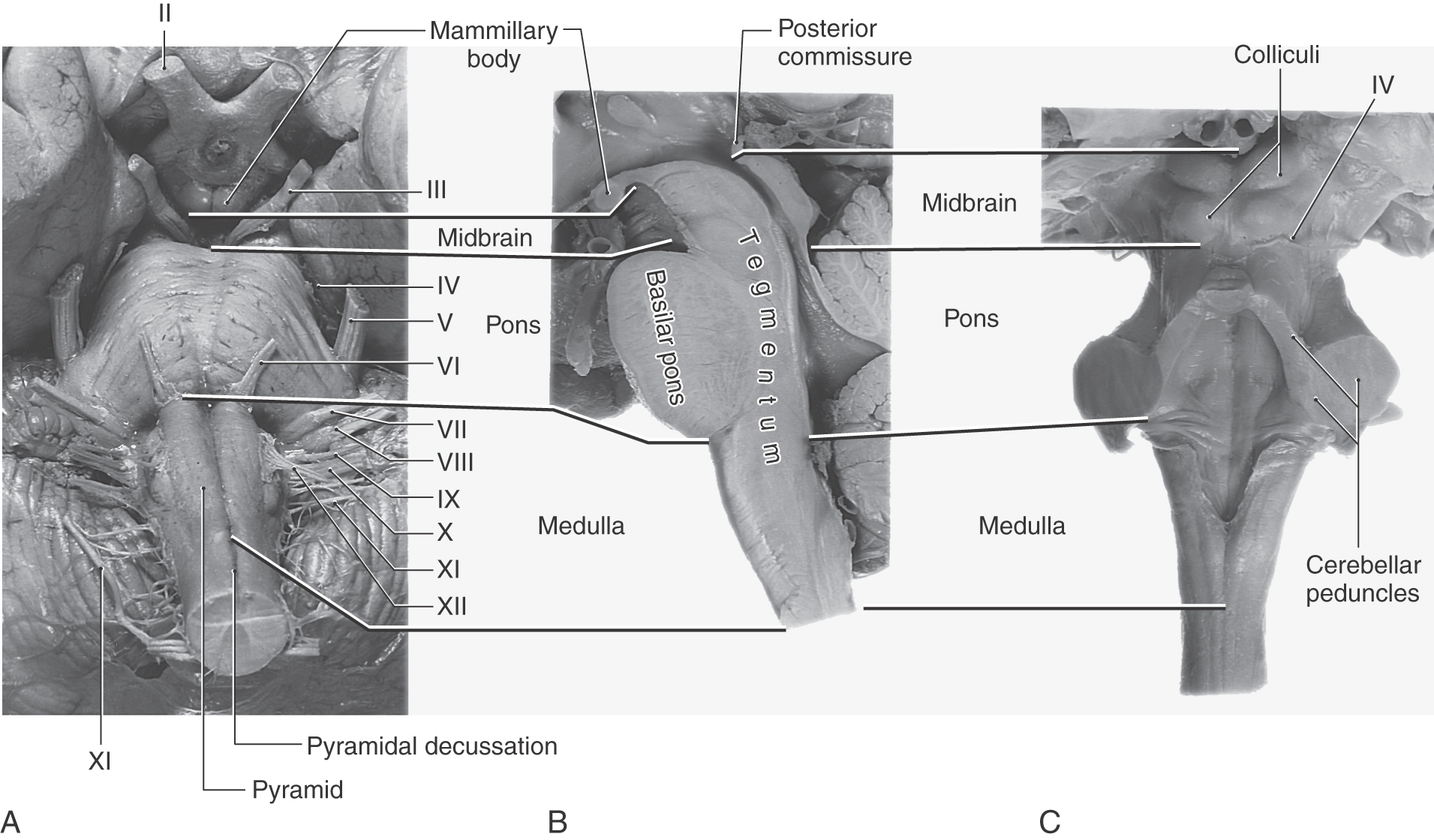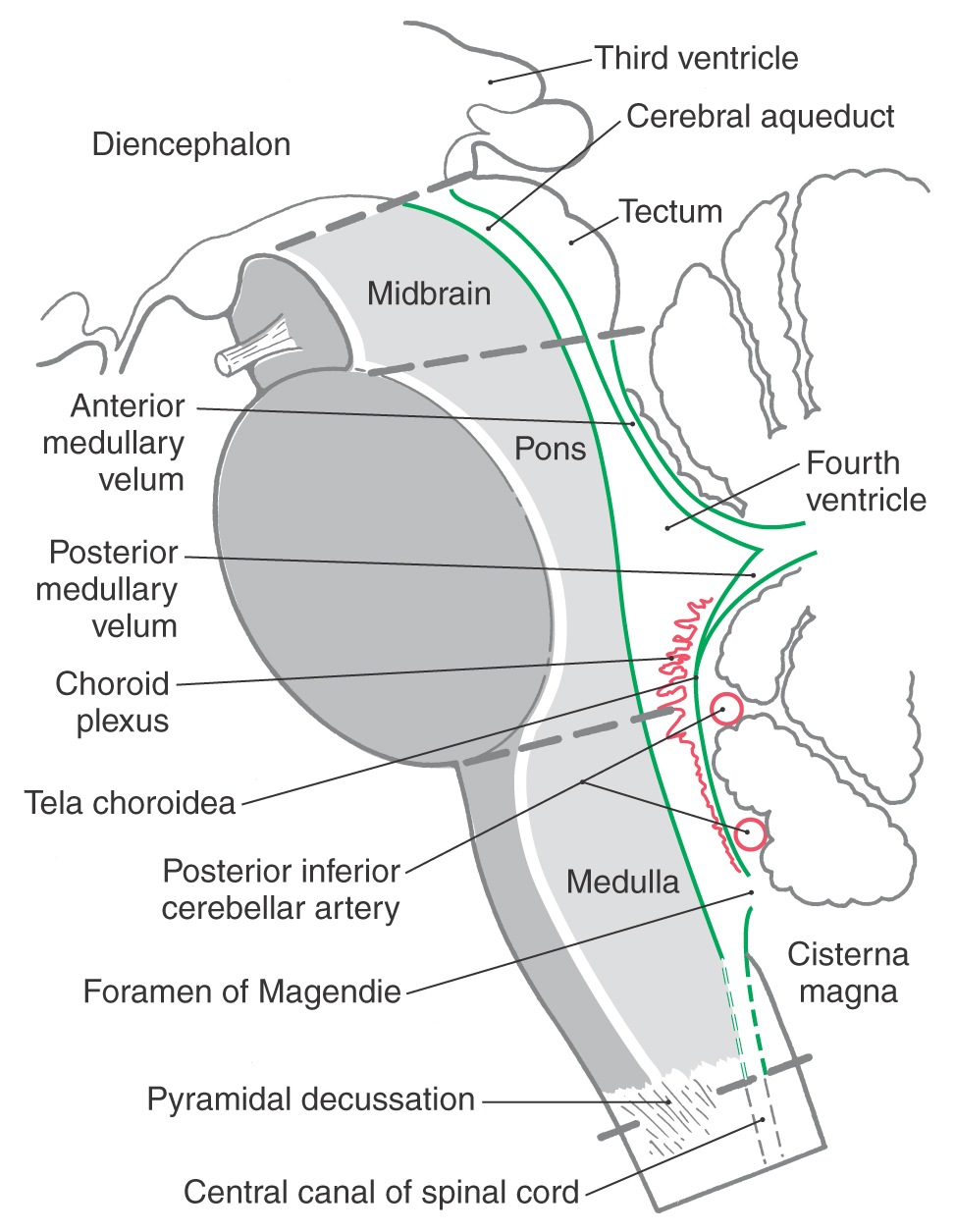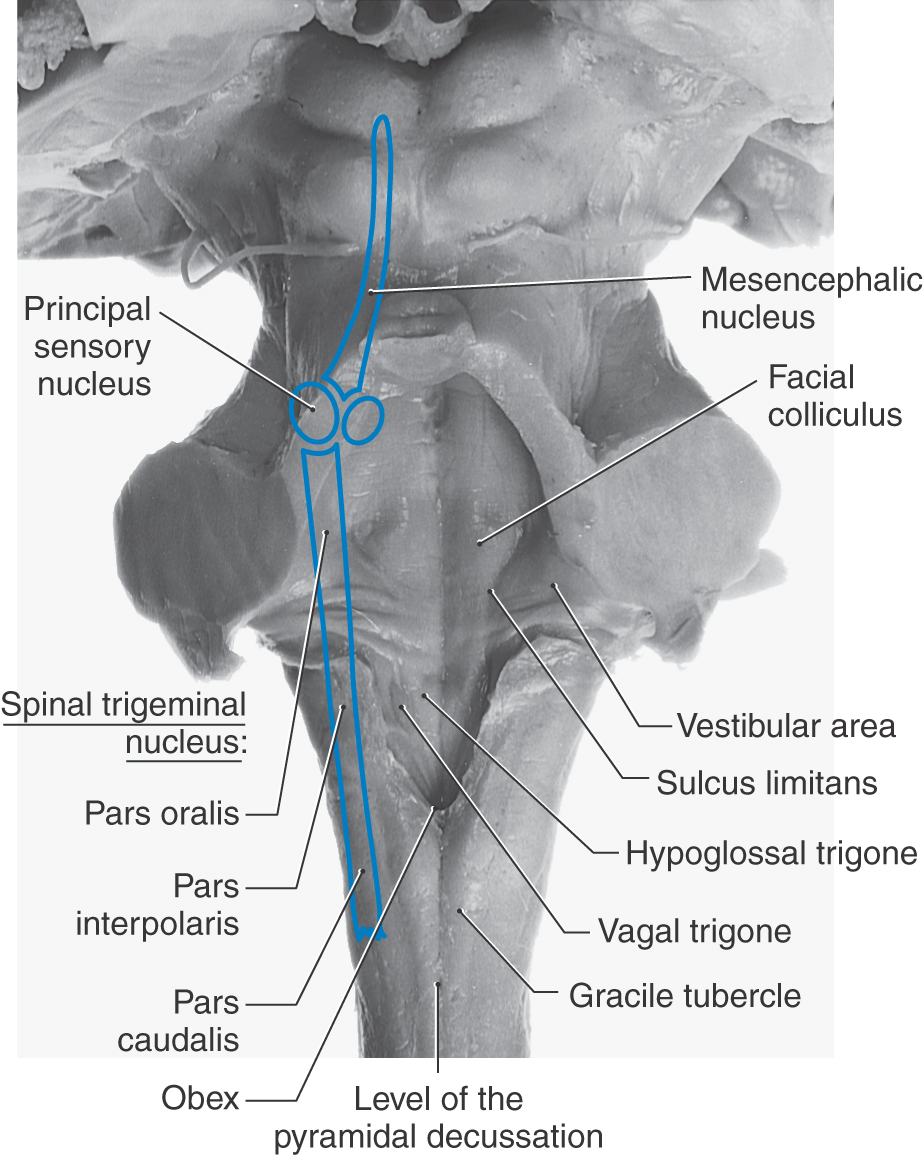Chapter 10
An Overview of the Brainstem
Basic Divisions of the Brainstem
Ventricular Spaces of the Brainstem
Cranial Nerve Nuclei and Their Functional Components
Contemporary View of the Functional Components of Cranial Nerves
Functional Components of Cranial Nerves and Their Associated Nuclei
The term brainstem (sometimes written brain stem) can mean either the portion of the brain that consists of the medulla oblongata, pons, and midbrain or the portion that consists of these structures plus the diencephalon. This book follows the former convention. For our purposes, therefore, the brainstem consists of the rhombencephalon (excluding the cerebellum) and the mesencephalon. These regions of the brainstem share a basic organization, which is the topic of this chapter. The medulla, pons, and midbrain are discussed in detail in Chapter 11 to Chapter 13.
BASIC DIVISIONS OF THE BRAINSTEM
Medulla Oblongata
At about the level of the foramen magnum, the spinal cord merges into the most caudal portion of the brain, the medulla oblongata or myelencephalon, commonly called the medulla. The foramen magnum marks the approximate location of the motor (pyramidal) decussation of the medulla (Fig. 10-1A). The medulla is slightly cone shaped and enlarges in diameter as it extends rostrally from the medulla–spinal cord junction toward the pons-medulla junction. On the posterior (dorsal) aspect of the medulla-pons continuum, this junction is represented by the caudal edge of the middle and inferior cerebellar peduncles, whereas anteriorly (ventrally) this border is formed by the caudal edge of the basilar pons (Fig. 10-1).
The cranial nerves associated with the medulla include the hypoglossal (XII, motor) and parts of the accessory (XI, motor), vagus (X, mixed), and glossopharyngeal (IX, mixed) nerves (Fig. 10-1A). The nuclei of the hypoglossal, vagal, and glossopharyngeal nerves as well as portions of the nuclei of the trigeminal nerve are located in the medulla.
The abducens (VI, motor), facial (VII, mixed), and vestibulocochlear (VIII, sensory) nerves are frequently called the cranial nerves of the pons-medulla junction because they exit the brainstem at this particular location (Fig. 10-1A).
Although the medulla does not have regions that are specifically regarded as tegmental or basilar (as is the case for the pons and midbrain), it does have regions that function in the same way and are rostrally continuous with these respective regions of the pons (Fig. 10-2). For example, the central regions of the medulla contain the cranial nerve nuclei affiliated with the medulla. This medullary area is rostrally continuous with the pontine tegmentum, which contains the cranial nerve nuclei associated with the pons. In similar manner, the pyramids of the medulla (containing corticospinal fibers) are located on the anterior (“basal”) aspect of the medulla and are rostrally continuous into the basilar pons (Fig. 10-2).
Figure 10-2. Midsagittal drawing of the brainstem. Ventricular spaces of the brainstem are outlined in green. The tegmental and basilar areas and contiguous areas of the medulla are shown in light and dark gray, respectively. Compare with Figure 10-1B.
Pons
The pons (the anterior part of the metencephalon) extends from the pons-medulla junction to an imaginary line drawn from the exit of the trochlear nerve posteriorly to the rostral edge of the basilar pons anteriorly (Fig. 10-1). What we commonly call the pons is actually composed of two portions, the pontine tegmentum (located internally; see Fig.10-1) and the basilar pons. The basilar pons is bulbous and quite characteristic of the anterior aspect of the pons. The pontine tegmentum contains portions of the trigeminal nuclei and the vestibular nuclei and, just rostral to the pons-medulla junction, the facial motor nucleus, superior salivatory nucleus, and abducens nucleus. The trigeminal nerve (V, mixed) emerges from the lateral aspect of the pons, and abducens (VI), facial (VII), and vestibulocochlear (VIII) nerves exit at the pons-medulla junction (Fig. 10-1A).
The cerebellum, although part of the metencephalon, is not part of the brainstem. It is joined to the brainstem by three large, paired bundles of fibers called the cerebellar peduncles. These are the inferior cerebellar peduncle, the middle cerebellar peduncle (or brachium pontis), and the superior cerebellar peduncle (or brachium conjunctivum), connecting the cerebellum to the medulla oblongata, basilar pons, and midbrain, respectively.
Midbrain
The midbrain (mesencephalon) extends rostrally from the pons-midbrain junction to join the diencephalon (thalamus); this interface is usually described as a line drawn from the posterior commissure posteriorly to the caudal edge of the mammillary bodies anteriorly (Fig. 10-1B). The oculomotor nerve (III, motor) exits the anterior aspect of the midbrain, whereas the trochlear nerve (IV, motor) exits its posterior aspect (Fig. 10-1A, C). The exit of the trochlear nerve is regarded as the pontomesencephalic junction on the posterior aspect of the brainstem; along with its decussating fibers, it composes the isthmus rhombencephali (the transition from pons to midbrain).
The posterior aspect of the midbrain is characterized by the superior and inferior colliculi and the anterior aspect by the crus cerebri and interpeduncular fossa.
Tegmental and Basilar Areas
The central core of the midbrain and the pons is called the tegmentum, and their anterior (ventral) parts are the basilar areas. These regions are continuous with each other and with comparable areas of the medulla (Figs. 10-1B and 10-2). The tegmentum of the pons and midbrain and the contiguous central portion of the medulla contain ascending and descending tracts, many relay nuclei, and the nuclei of cranial nerves III to XII.
The basilar part of each brainstem division is anterior to the tegmentum (of the midbrain and pons) and to the central portion of the medulla (Fig. 10-2). Consequently, these basilar structures also form a rostrocaudal continuum. Basilar structures of the brainstem include the descending fibers of the crus cerebri (midbrain), basilar pons, and pyramid (medulla) and specific populations of neurons in the midbrain and pons that originate from the alar plate of the embryonic brain.
VENTRICULAR SPACES OF THE BRAINSTEM
The ventricular spaces of the brainstem are the cerebral aqueduct in the mesencephalon and the fourth ventricle in the rhombencephalon (Fig. 10-2). The cerebral aqueduct is a narrow channel, 1 to 3 mm in diameter, that connects the third ventricle (the cavity of the diencephalon) with the fourth ventricle (the rhombencephalic cavity). The cerebral aqueduct contains no choroid plexus; its walls are formed by a continuous mantle of cells collectively called the periaqueductal gray. The roof of the midbrain is the tectum.
The fourth ventricle is the cavity of the rhombencephalon. Its rostral portion lies between the pons and cerebellum, and its caudal part is located in the medulla (Fig. 10-2). The fourth ventricle is continuous rostrally with the cerebral aqueduct, caudally with the central canal of the caudal medulla and cervical spinal cord, and laterally with the subarachnoid space via the midline foramen of Magendie and the two lateral foramina of Luschka. The foramen of Magendie is located in the caudal roof of the ventricle and opens into the dorsal cerebellomedullary cistern (cisterna magna) (Fig. 10-2). The lateral recesses of the fourth ventricle extend around the brainstem at the pons-medulla junction and end at the foramen of Luschka, which opens into the lateral cerebellomedullary cistern (Fig. 10-4; see also Fig. 6-9).
Figure 10-4.











